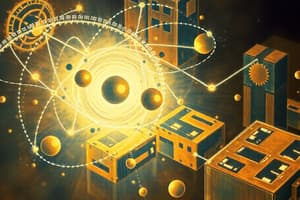Podcast
Questions and Answers
किसके परिपेक्ष में विद्युत् धारा क्या है?
किसके परिपेक्ष में विद्युत् धारा क्या है?
- विद्युत् धारा गैल्वैनीज़े के सिद्धांत पर होती है
- विद्युत् धारा गुरुत्वाकर्षण के माप पर होती है
- विद्युत् धारा विद्युत् ध्वनि के आधार पर होती है
- विद्युत् धारा चार्ज के आलंब में होती है (correct)
किस कारण से मग्नेटों के बीच संबंध उत्पन्न होता है?
किस कारण से मग्नेटों के बीच संबंध उत्पन्न होता है?
- चुंबकीय धरोहर (correct)
- गुरुत्वाकर्षण
- प्रकृति का समर्थन
- मेघ संघनन
मेघ के साथ क्या काम करता है?
मेघ के साथ क्या काम करता है?
- प्रकाश (correct)
- प्रसंस्था
- प्रसंग
- प्रकार
कुलंब के कायम नियम से किसे नियंत्रित किया जाता ह।
कुलंब के कायम नियम से किसे नियंत्रित किया जाता ह।
किसे मेघों में 2 ध्रुव होते हैं?
किसे मेघों में 2 ध्रुव होते हैं?
किसका एक प्रमुख काम है वर्तमान को विद्युत प्रवाहित परिपथि के साथ खेलना?
किसका एक प्रमुख काम है वर्तमान को विद्युत प्रवाहित परिपथि के साथ खेलना?
सुपरकंडक्टिविटी का क्या महत्व है निम्नलिखित में?
सुपरकंडक्टिविटी का क्या महत्व है निम्नलिखित में?
मैग्नेटिक रेजोनेंस इमेजिंग कैसे काम करता है?
मैग्नेटिक रेजोनेंस इमेजिंग कैसे काम करता है?
मैग्नेटिक लेविटेशन का मुख्य काम है क्या?
मैग्नेटिक लेविटेशन का मुख्य काम है क्या?
किस डिवाइस को महत्वपूर्ण समझा जाता है, quantum mechanics में मौजूद particles like electrons पर magnetic properties को प्रकट करने?
किस डिवाइस को महत्वपूर्ण समझा जाता है, quantum mechanics में मौजूद particles like electrons पर magnetic properties को प्रकट करने?
Study Notes
Diving into Electricity and Magnetism: Two Pillars of Physics
Electricity and magnetism, intertwined yet distinct, have shaped our world with the promise of harnessing their power for a better tomorrow. From the telegraphs that connected continents to the high-speed internet that unites us, these fundamental forces of nature have fueled technological advancements and continue to inspire curiosity in physicists.
Electricity
Electricity is the flow of electric charge, which results from the movement of particles known as electrons along a conductive path. This flow can occur naturally, as in lightning, or through design, as in power grids. The electric force between two charged particles drives this flow, and it is governed by Coulomb's Law.
At the atomic level, electrons revolve around the nucleus of atoms, forming shells. When an atom gains or loses electrons, it can become electrically charged, and thus, an electric current may flow. Understanding electricity has led to the development of everything from the humble lightbulb to the intricate computer systems that power our daily lives.
Magnetism
The invisible force that makes compass needles point north is magnetism. While it is less intuitive than electricity, magnetism arises from the motion of electric charges and the magnetic properties of materials. Magnets have two poles, north and south, and they attract or repel each other based on their polarity.
The fundamental law governing magnetism is the Biot-Savart Law, which relates the magnetic field to the current flowing in a conductor. Magnetism is not only essential to understanding the behavior of electric currents but also crucial in the realm of quantum mechanics, where particles like electrons exhibit magnetic properties.
Applications in Physics and Engineering
The interplay between electricity and magnetism has led to a vast array of applications in both physics and engineering.
- Transformers and coils allow us to manipulate electric currents and voltages, making long-distance power transmission possible.
- Superconductivity, which occurs when a material's electrical resistance falls to zero at low temperatures, has the potential to revolutionize energy efficiency and reduce the carbon footprint of our electrical infrastructure.
- Magnetic resonance imaging (MRI) and nuclear magnetic resonance (NMR) rely on the response of atomic nuclei to external magnetic fields to provide detailed, non-invasive images of biological structures.
- Magnetic levitation and linear induction motors have made high-speed transportation, such as Maglev trains, a reality.
Career Opportunities
For those seeking a career in the fields of electricity and magnetism, opportunities abound. Physicists and engineers in academia, industry, government, and private companies all contribute to the advancement of knowledge and technology.
- In academia, researchers may focus on theory, experiment, or computation, while teaching the next generation of physicists and engineers.
- In industry, physicists and engineers work on the development of new technologies and materials, as well as optimizing existing systems.
- In government, research is geared toward national security, space exploration, and addressing societal challenges such as climate change and clean energy.
- In private companies, physicists and engineers develop innovative solutions to meet the technological needs of their clientele.
A Thriving Field
The field of electricity and magnetism is ever-evolving, and the possibilities for exploration and discovery are endless. Whether you're seeking the thrill of discovery in academia or the promise of innovation in industry, the realms of electricity and magnetism offer a world of opportunity for those ready to dive in.
Studying That Suits You
Use AI to generate personalized quizzes and flashcards to suit your learning preferences.
Description
Explore the intertwined yet distinct forces of electricity and magnetism that have shaped our world through technological advancements and scientific discoveries. Learn about the flow of electric charge, magnetic fields, applications in physics and engineering, and career opportunities in this dynamic field.




